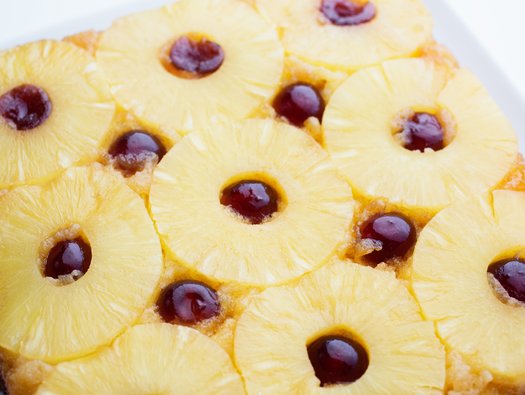Pineapple upside-down cake

An attractive, traditional dessert using cherries and tinned pineapple to keep it low in potassium for an occasional treat.

An attractive, traditional dessert using cherries and tinned pineapple to keep it low in potassium for an occasional treat.
50g unsalted butter
50g light soft brown sugar
9 pineapple rings in fruit juice
9-10 glace cherries
150g soft unsalted butter
150g golden caster sugar
150g self-raising flour
1.5 teaspoon baking powder
3 eggs
Heat your oven to 180°C / 160°C fan / gas mark 4. Halve the glace cherries. To make the topping, beat the butter and soft brown sugar together until creamy. Spread the mix over the base and up sides of a high sided cake pan as this will caramelise the cake topping.
Lay 8-9 pineapple rings in the base of the pan and place the glace cherries into the centre of the pineapple rings and fill gaps. Keep the pineapple juice aside to use later.
Add all the cake ingredients into a mixer along with 3 tablespoons of pineapple juice and whisk until a soft consistency or beat together with a spoon until well combined.
Spoon the mix onto the top of the pineapple rings and smooth over until level. Bake for approximately 20-25 minutes, until golden. Remove from the oven and leave to stand for 5 minutes then turn it out onto a plate.
The main source of carbohydrate in this dish comes from the sugar, pineapple and flour. The carbohydrate value of this dish has been provided for those who have been trained in insulin adjustment.
Tinned fruits with the juice drained and discarded tend to be lower in potassium than fresh. The phosphate in this dish comes mainly from the flour, eggs and baking powder so if you have been advised to restrict your phosphate then have a smaller portion size.
If you have been prescribed a phosphate binder, ensure you take them with this dish.
Use gluten-free flour.
It’s okay to have an occasional treat. However if you have diabetes or want to reduce the calories in this dish then we recommend using a lower fat spread instead of the butter and using an artificial sweetener to replace some or all of the sugar in either the base or the topping.
Using tinned fruit is a relatively inexpensive way to incorporate more fruit in your diet.
Keep it refrigerated and use any leftovers within three days.
Living with kidney disease doesn’t mean missing out on all baked goods, even on a low-phosphate diet. Kidney Kitchen recommends some tips and tweaks to help make your bakes a little more kidney-friendly.
You can enjoy a wide variety of delicious and healthy food when you are living with kidney disease. All Kidney Kitchen recipes are analysed and approved by kidney dietitians. Search through our kidney-friendly recipes or filter them by category below.
A deliciously moist carrot cake with a cream cheese icing and a passion fruit curd. This cake makes delicious use of leftover bread for an indulgent, low potassium treat.
By giving us your email address, you're giving us permission to send you the latest news from Kidney Care UK. Further information about how we protect and use your personal data is available in our Privacy policy. If you would like to change the way we communicate with you at any time please email [email protected]. You can unsubscribe at any time by using the link at the bottom of every email we send.